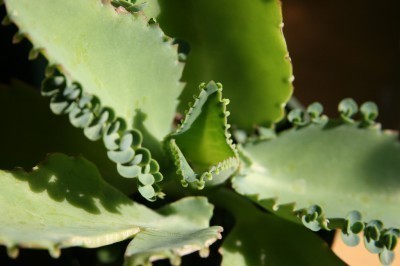






Growing mother of thousands (Kalanchoe daigremontiana) provides an attractive foliage houseplant. Though rarely blooming when kept indoors, the flowers of this plant are insignificant, with the most interesting feature being the baby plantlets continually appearing on the tips of the large leaves.
When growing mother of thousands as an outdoor plant in USDA hardiness zones 9 -11, it may bloom with small, grayish lavender flowers in late winter. The mother plant then dies, but is replaced by tiny plantlets thatcan drop and cause the plant to be considered invasive. For this reason, most gardeners find growing mother of thousands works best in a container.
Mother of thousands is of the Crassulaceae family and is related to jade plant and Flaming Katy (Kalanchoe blossfeldiana). It is often confused with the chandelier plant (Kalanchoe delagoensis) but shares similar growing conditions and traits.
According to mother of thousands plant info, Kalanchoe daigremontiana has lost the ability to produce seeds and only reproduces from plantlets. As it is an abundant producer, it can quickly get out of hand when dropping these baby plantlets.
While this provides numerous plants for the propagating gardener, those uninterested in the addition of more plants may find caring for mother of thousands a bit tedious. Don’t worry about disposing of the plantlets though, because more are sure to appear on the healthy, still growing mother of thousands.
This succulent plant can resist drought, though performance is better when regularly watered. Like its relatives, Kalanchoe daigremontiana, does not need frequent fertilization. If you wish to feed when experimenting with how to grow Kalanchoe plants, do so only once every few months.
This plant does need good drainage and is best potted in a commercial cactus soil mix. If using standard potting soil, sand can be added for sharper drainage.
When learning how to grow Kalanchoe indoors, locate the plant in bright, but indirect light for several hours per day. When growing Kalanchoe outdoors, avoid direct afternoon sun. Houseplants will benefit from spending the summer outside; just make sure to introduce them to the outside atmosphere gradually and begin their outdoor stay with limited morning sun. Too much direct sunlight may cause leaves to become sunburned. Remember to move the plant back inside before outdoor temperatures drop to the 40 degree F. range. (4 C.).
You’ll find that growing mother of thousands is simple and mostly carefree – a worthwhile gardening experience with limited care to keep it under control.
Copyright © www.100flowers.win Botanic Garden All Rights Reserved